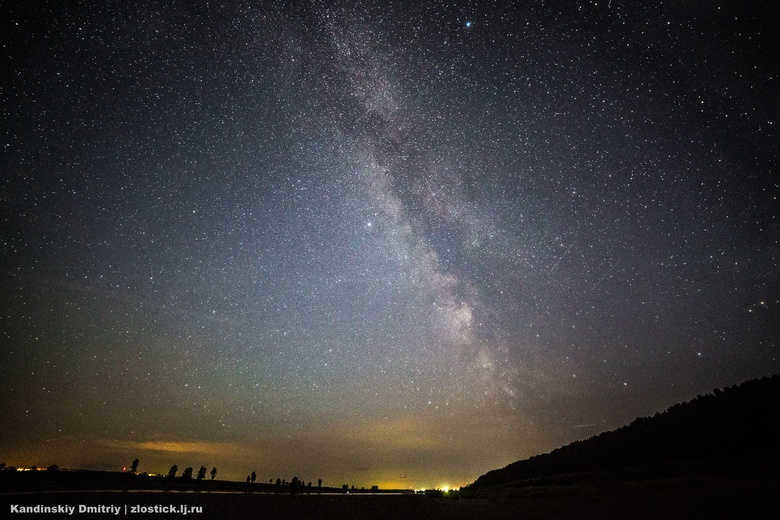
In late August to September, Saturn will be visible to Earth’s inhabitants under clear skies. During this time, the planet will be on the opposite side of the Sun in relation to Earth, making it the closest it can be to our planet. As a result, Saturn will appear larger and brighter than usual, a phenomenon known as opposition. Astronomers suggest that Saturn, appearing as a bright star, will be visible to the naked eye, while amateur telescopes can reveal more details, including the planet’s iconic rings.
Saturn’s opposition
According to Tomsk planetarium astronomer-observer Eugene Parfenov, all outer planets experience periods of visibility, during which they come closest to Earth and appear at their brightest. This occurs once a year.
“Jupiter has a slightly longer year than Earth – 13 months, while Saturn has a year of 12.5 months. Uranus and Neptune have a year that is slightly longer than Earth’s by a few days. This difference in length is due to the combination of the planet’s orbit around the Sun and the Earth’s orbit around it. The most challenging time to observe distant planets is when they are in the sky on the opposite side of the Sun. There are also periods when a planet is on the opposite side of the Sun while the Earth is on the same side, creating a configuration where the planet is situated between the Sun and the Earth. During these moments, the Earth is as close as possible to the planet. Saturn will be approaching Earth at the end of August, providing a great opportunity for observation. However, in six months, the planet will be relatively behind the Sun, making it invisible to us,” the astronomer explained.
Opposition occurs when a planet is situated farther from the Sun than the Earth, as it necessitates the Earth to be positioned between the Sun and the planet. The celestial bodies that can be in opposition include Mars, Jupiter, Saturn, Uranus, and Neptune.
Having said that, Saturn is the farthest planet visible to the naked eye. Astronomers predict that Uranus and Neptune will no longer be visible in this manner.
When is the best time to observe?
As per astronomers, Saturn will be fully illuminated by the Sun and shine at its brightest during the opposition, which is scheduled to occur on August 27th around 6:00 PM Moscow time.
The opposition period for the planet lasts for a few weeks, even though the planet is in opposition at a specific moment in time. You can observe the planet on any convenient day during this period. Saturn will rise on the opposite side of the Sun just after sunset, reach its highest point in the sky at midnight, and set before dawn.
To catch a glimpse of Saturn, you should select the nearest day to the opposition when the sky is clear and embark on a search for the planet.
Experts say that there will be a unique phenomenon called the “Zeliger effect” where Saturn’s rings will appear exceptionally bright in the days leading up to and following the opposition. During the opposition, Saturn is directly illuminated by the Sun when observed from Earth, resulting in the planet and its ring particles being fully illuminated without any shadowing. Additionally, the light from the Sun hits each individual particle and undergoes multiple reflections, further enhancing the brightness of the rings.
How to locate Saturn in the sky, where to search?
In relation to Earth, the planet can be found at an apparent angular separation of 180 degrees from the Sun in the sky during the time of opposition – when the Sun sets in the west, the planet emerges in the east.
Therefore, to locate Saturn during the opposition in late August, it is necessary to direct your gaze towards the opposite direction of sunset.
According to the astronomer from Tomsk, Saturn will be highly visible, ensuring that you will be able to spot it in the sky.
Can the rings of Saturn be observed? Is a telescope necessary? Can they be seen without any optical aid?
To observe any details on the planets, a telescope is necessary. However, as a point-like object in the sky, the planets should be visible to the naked eye, including Saturn. To the naked eye, Saturn will appear as a bright yellow star. We have already determined where to look for it.
Astronomers emphasize that even with the simplest optics, it will be possible to see Saturn, particularly its recognizable rings, in a clear sky. In some cases, the planet can even be seen larger through binoculars or a telescope.
Astronomers explain that through binoculars, the planet will have an oval shape, while with a small telescope, Saturn’s rings, including Cassini’s Gap, as well as its largest satellite Titan, can be observed.
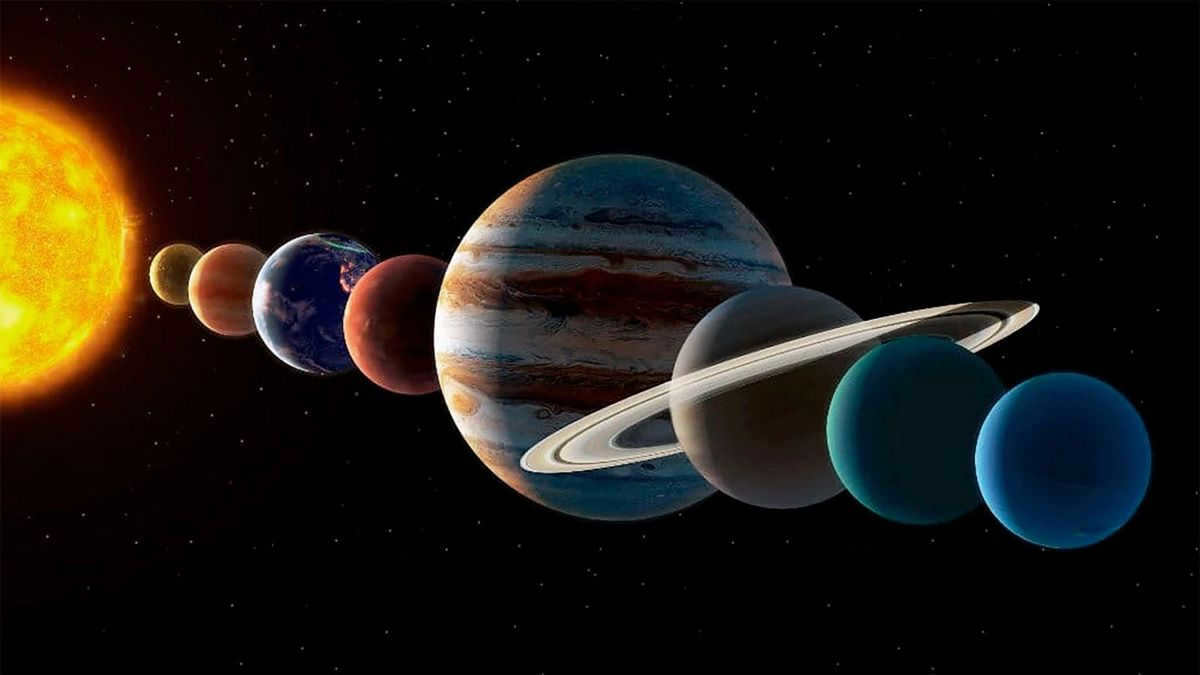
There is a rare astronomical event called a planetary alignment, also known as a planet parade, that Russians will have the opportunity to observe on the evening of Tuesday, March 28. This phenomenon occurs when several planets align closely together on one side of the Sun. It can be seen by people in the Northern Hemisphere, including all of Russia. The best time to start observing is shortly after sunset. The Star Walk portal, which is dedicated to studying celestial phenomena, has reported this event.
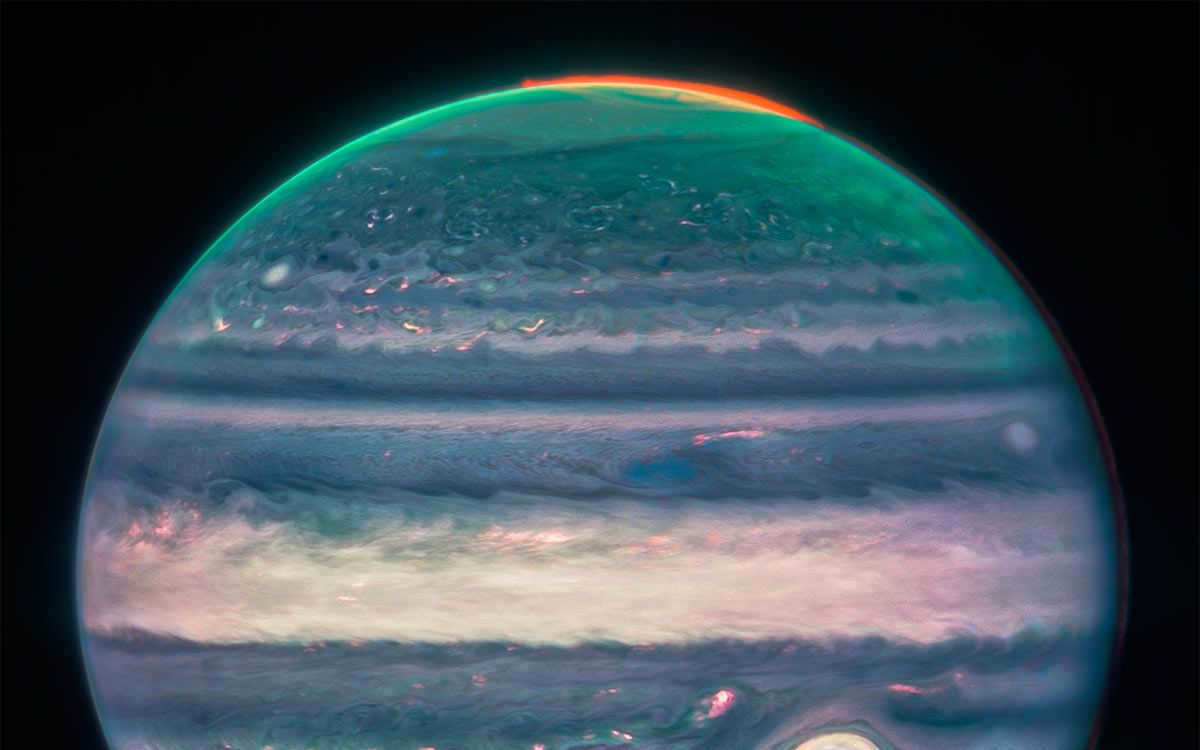
NASA has unveiled stunning photographs of Jupiter. What was visible in the images
Today, Jupiter, Mercury, Venus, Uranus, and Mars will align in a narrow 50-degree portion of the celestial sphere. The best views will be of Mercury and Jupiter. To observe Uranus and Neptune, binoculars will be necessary.
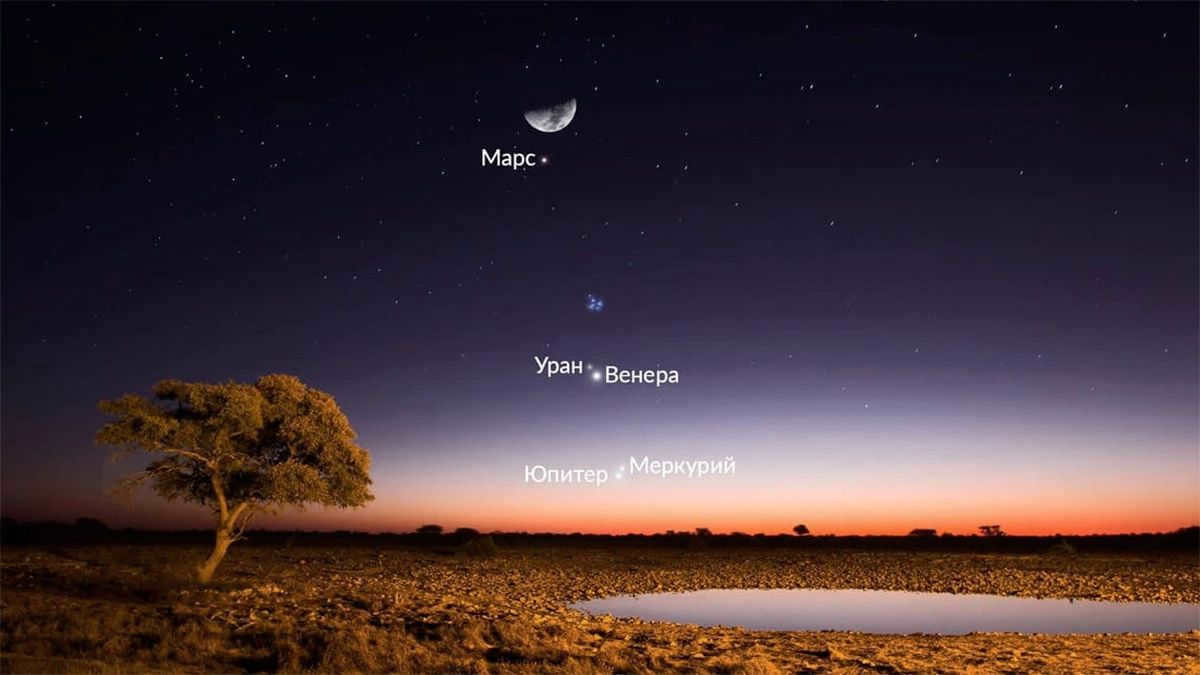

The planets will align in a magnificent display on the evening of March 28, as seen from the Northern Hemisphere. This alignment will be observed in the Pisces constellation, with Jupiter and Mercury shining brightly and positioned approximately 1° apart. In the higher regions of the sky, the constellation Aries will be adorned by the radiant presence of Venus. By utilizing a pair of high-quality binoculars, it may be possible to catch a glimpse of Uranus in close proximity to Venus, shining at a distance of approximately 2°. Mars will also be visible, shining brightly alongside the waxing Moon in the Gemini constellation.
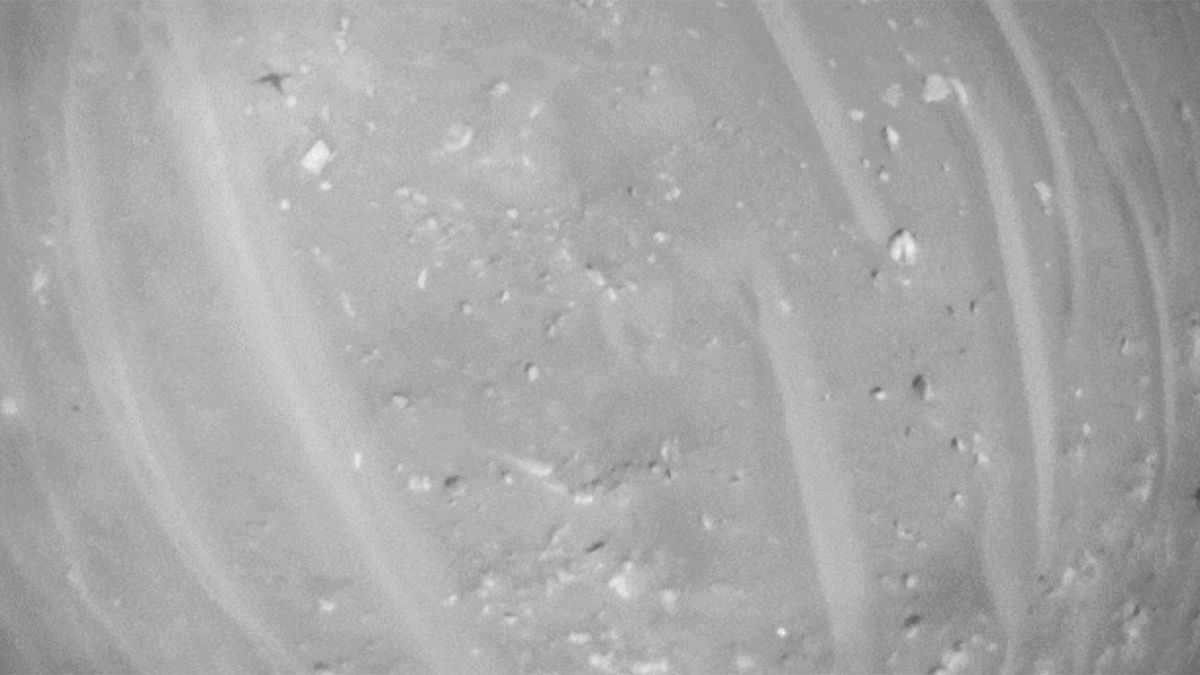
The dunes and rocks were photographed by the helicopter on Mars, while the rover was unable to do so
According to the website’s authors, March 28 is the optimal day for observations, but the alignment will remain visible for a few more days after that.
The next opportunity to observe the alignment will be on April 11, when Mercury, Uranus, Venus, and Mars will form a small parade in the 33-degree section of the sky.
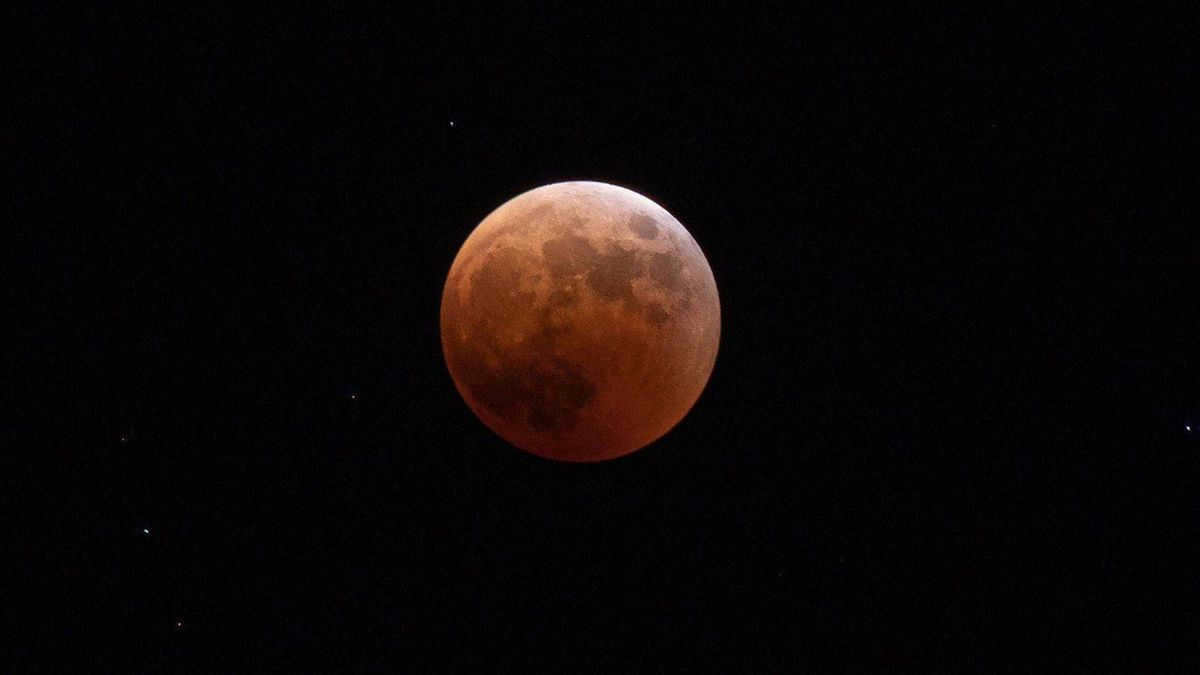
A video of the Red Moon was captured during the total eclipse
In St. Petersburg, a stunning sight of a massive moon near the Smolny Cathedral was photographed. Just a few days before that, avid nature observers in the Leningrad region and later in the Moscow region were able to capture the mesmerizing beauty of the powerful northern lights through photos and videos.

On January 26, 2023, SpaceX successfully launched an additional set of Starlink telecommunication satellites, consisting of 54 satellites. This particular mission, known as Starlink 5-2, marks the 71st launch in the project’s history. As of now, there are already over three thousand satellites deployed in orbit, with the potential for the constellation to eventually reach a size of anywhere between 12 (already approved) and 42 (pending ITU approval) thousand satellites.
With this upcoming launch, and many more to come, it’s worth noting that you can track various space objects, including satellites and planets, using just your computer or smartphone, without the need for any optical equipment such as telescopes.
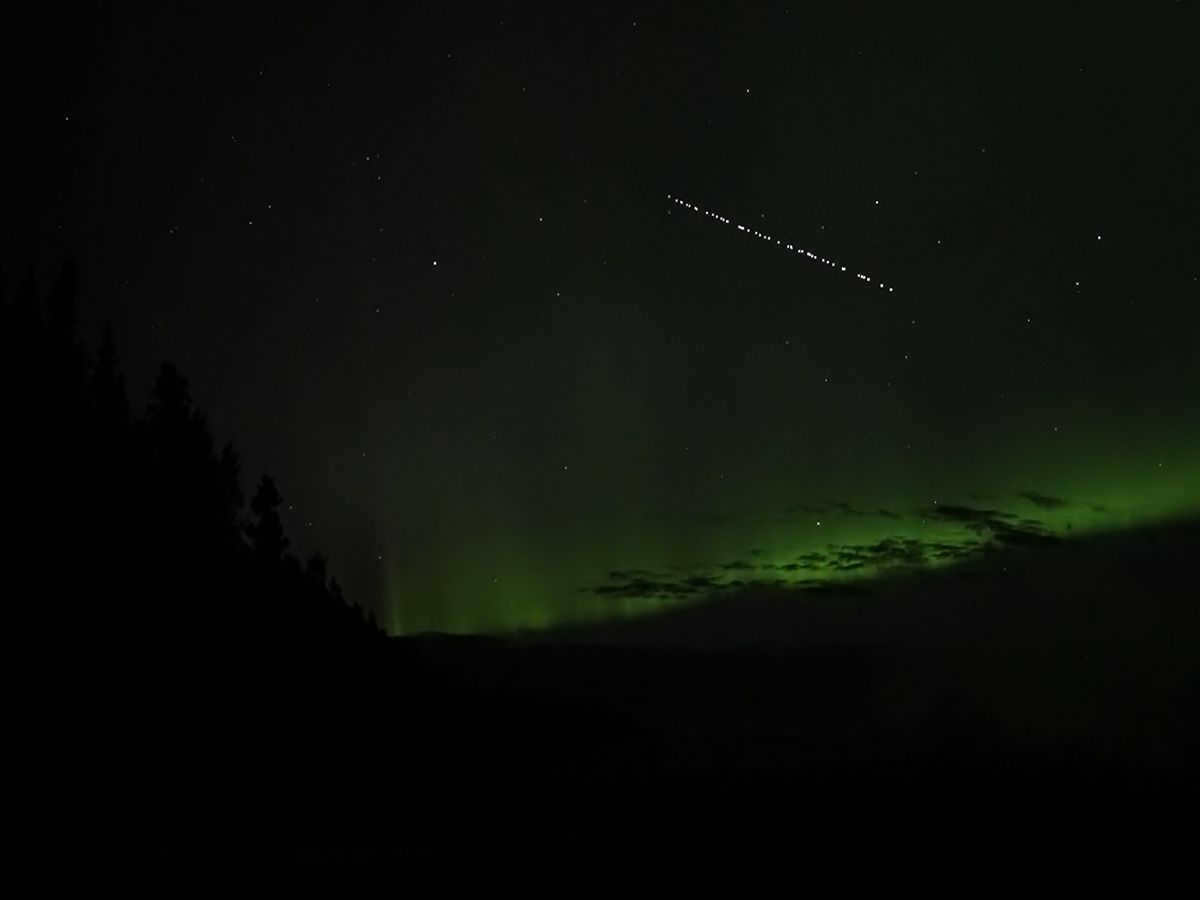
What can be observed without the need for a telescope?
Since ancient times, humanity has been gazing up at the heavens, long before the invention of the telescope. When it comes to sky watching, it’s important to consider the classification of celestial objects, which can be categorized as either natural or artificial. Among the natural objects that can be seen without the aid of a telescope are the Sun, the Moon, and countless stars. Additionally, with nothing more than the naked eye, one can spot the planets Mars, Mercury, Venus, Saturn, and Jupiter.
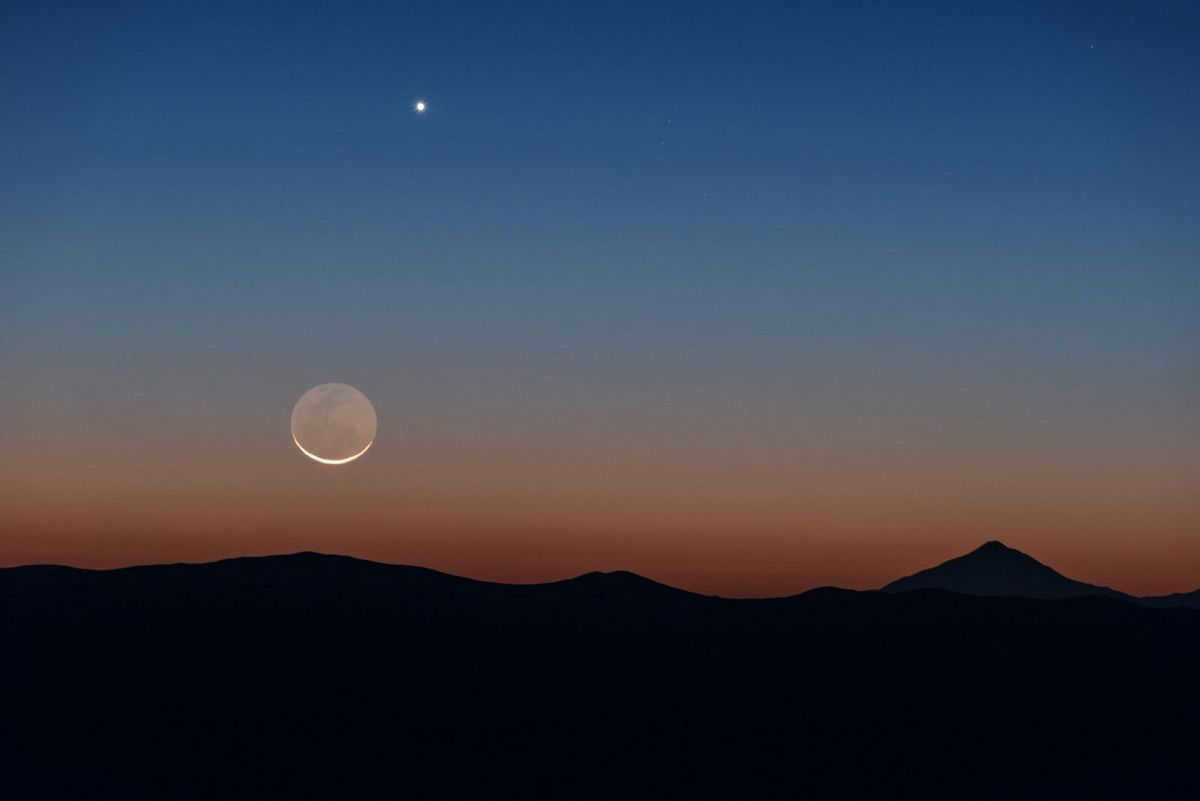
There is an abundance of vehicles and satellites in orbit today, making artificial bodies a common sight. While most people are familiar with observing natural celestial bodies since childhood, not everyone is aware that it is also possible to observe artificial ones without a telescope, such as the ISS.
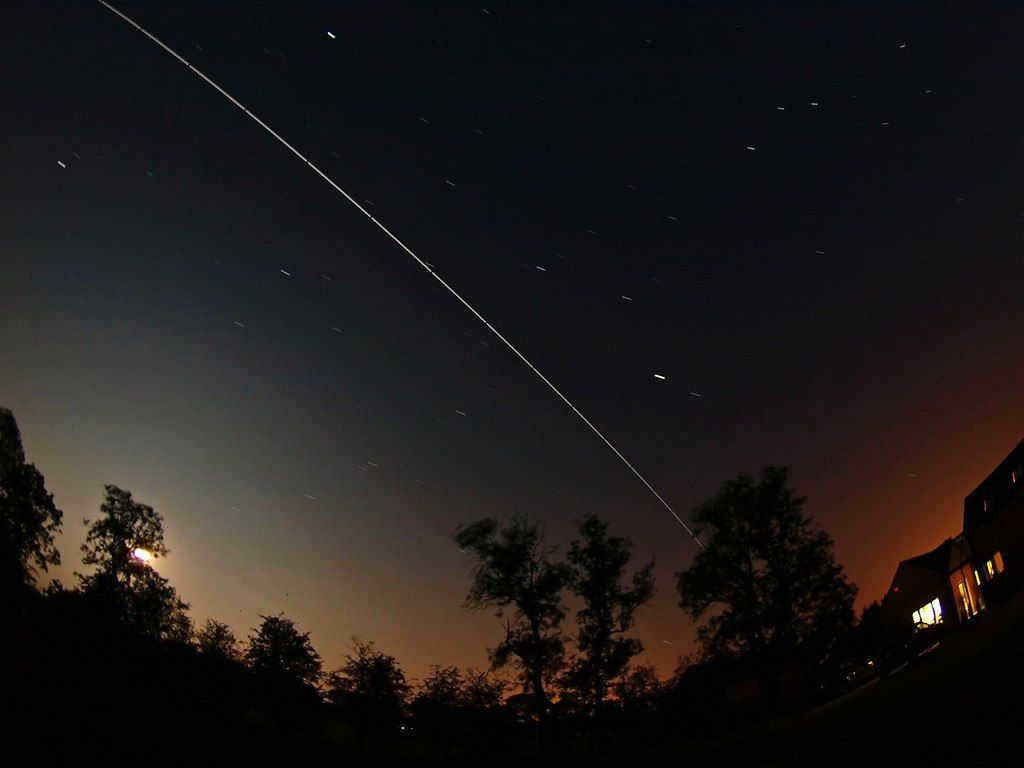
Initially, one can stumble upon celestial entities by chance, simply by gazing upwards at an opportune moment. However, given their precise positional data, one can ascertain a specific timeframe for their transit, as well as the region in the heavens and their rough trajectory. Manual calculations are unnecessary, as there are numerous websites and applications dedicated to satellite tracking. By following the correct procedures, one can catch a glimpse of the coveted luminous dot in the firmament.
- When it comes to observing objects with the naked eye, the vision of the observer plays a significant role. For example, someone with poor eyesight of minus two may have a lower chance of seeing a bright object like the ISS compared to someone with excellent eyesight.
- The visibility of satellites is influenced by the time of day. They can only be seen when they are illuminated by the sun while the observer is in the dark. Additionally, the satellites must not be in the Earth’s shadow, meaning the sun should be below the horizon but not too low during the observation period. As a result, satellites are typically observed for several hours before sunrise or after sunset.
- Light pollution. The sky becomes obscured by artificial lighting, diminishing the visibility of astronomical objects. The optimal conditions for observing the sky involve complete darkness, away from urban areas, and free from any additional sources of light. To determine the best location with minimal light pollution, you can visit specialized websites such as Light Pollution Map and Dark Site Finder.
- Weather. Naturally, cloud cover or fog can obstruct your view of celestial objects. You can predict the cloud levels in your area by using various websites like Ventusky.
Up until the conclusion of 2019, it was feasible to observe the solar flares from the spacecraft of the Global Satellite Communications System “Iridium“. These flares happened due to the reflection of light from the aluminum antennas of communication on the Earth’s surface. These occurrences were brief, typically lasting only a few seconds, but they were incredibly bright – the flares could reach magnitudes as low as -8. Regrettably, in December 2019, the final Iridium with glare antennas was retired, and one less celestial phenomenon graced the heavens.
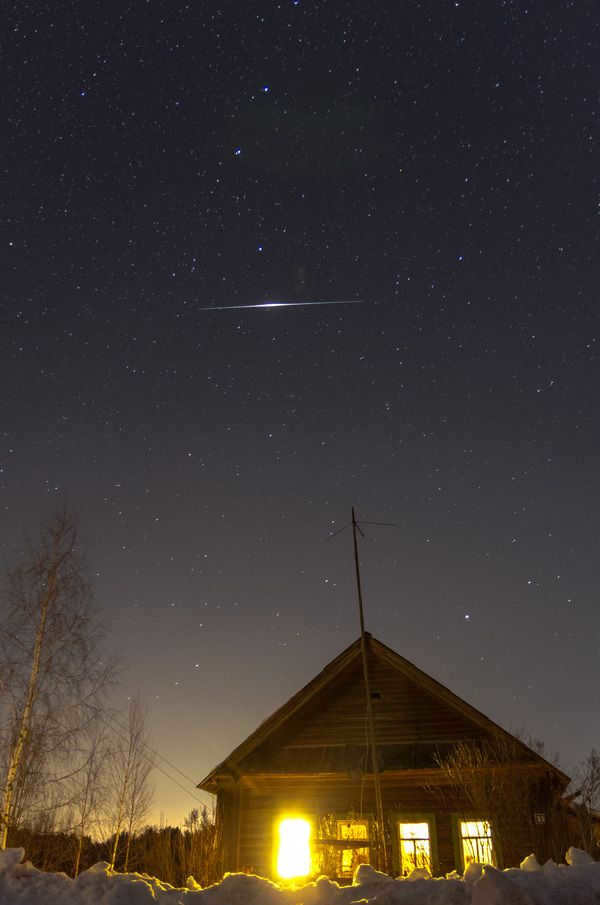
However, in the same year 2019, the serial releases of Starlink commenced, which are also captivating for observation. Due to the fact that satellites are launched in large groups, several dozen at a time, they transform into a string of numerous luminous dots gliding through the sky for terrestrial observers. The cohesion of such a “train” is short-lived – after some time, the satellites disperse into operational orbits – but it is still feasible to plan observations.
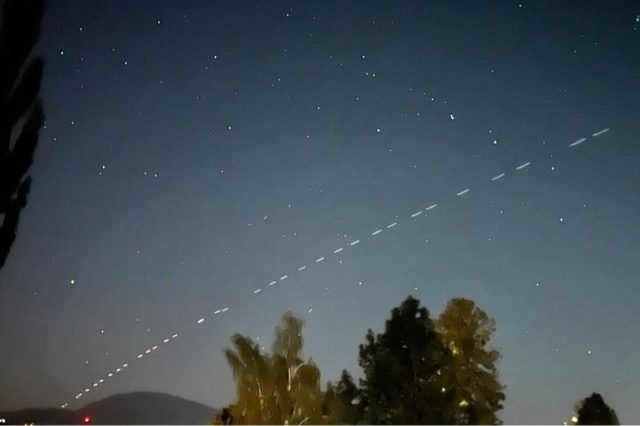
Currently, the formations of “Starlinks” are perhaps the most captivating astronomical occurrence that can be observed without the aid of a telescope. Another notable object in the sky is the ISS, which, following the retirement of the Iridiums, remains one of the brightest man-made entities that regularly traverses the heavens (with an average apparent stellar magnitude of -1.1 in the Moscow region). However, the ISS can be witnessed on a daily basis and appears as a solitary point in the sky (albeit a luminous one), whereas the launches of Starlink satellites are less frequent. Attached below is a link to a video recording of the Starlink satellite launch on January 19, 2023.
With the increasing number of SpaceX launches these days, there is a rising fascination with observing Starlinks from the ground. As a result, a comprehensive article about this topic was recently published by the Washington Post. However, as time progresses, there is also a growing likelihood that the Starlink satellites from future launches will be intentionally “dimmed” to prevent them from being visible in the night sky. The rationale behind this is that the reflected light from these satellites creates issues for astronomers and hampers the quality of astronomical photographs (if you’re curious, you can refer to a study conducted by the European Southern Observatory on the impact of such satellite constellations on astronomical observations).
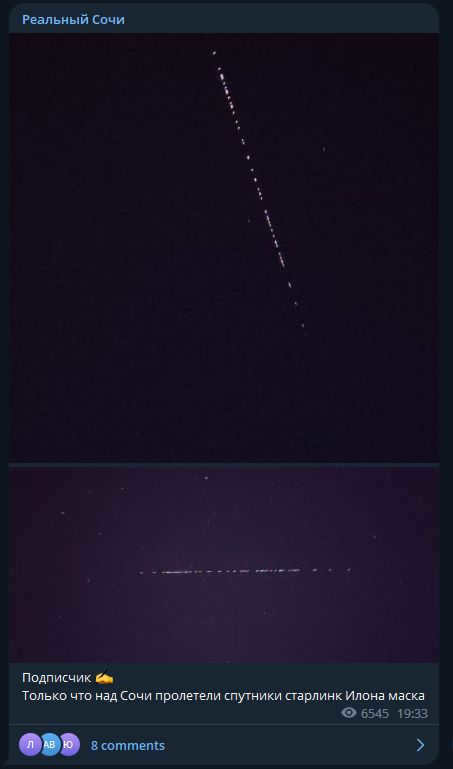
Meteor showers, such as the Geminids in December and the Perseids in July-August, are particularly fascinating natural phenomena. It is important to note the fundamental distinction between a meteor and a meteorite: a meteor is an object that disintegrates in the Earth’s atmosphere, whereas a meteorite is a fragment that survives the journey through the atmosphere and lands on Earth.
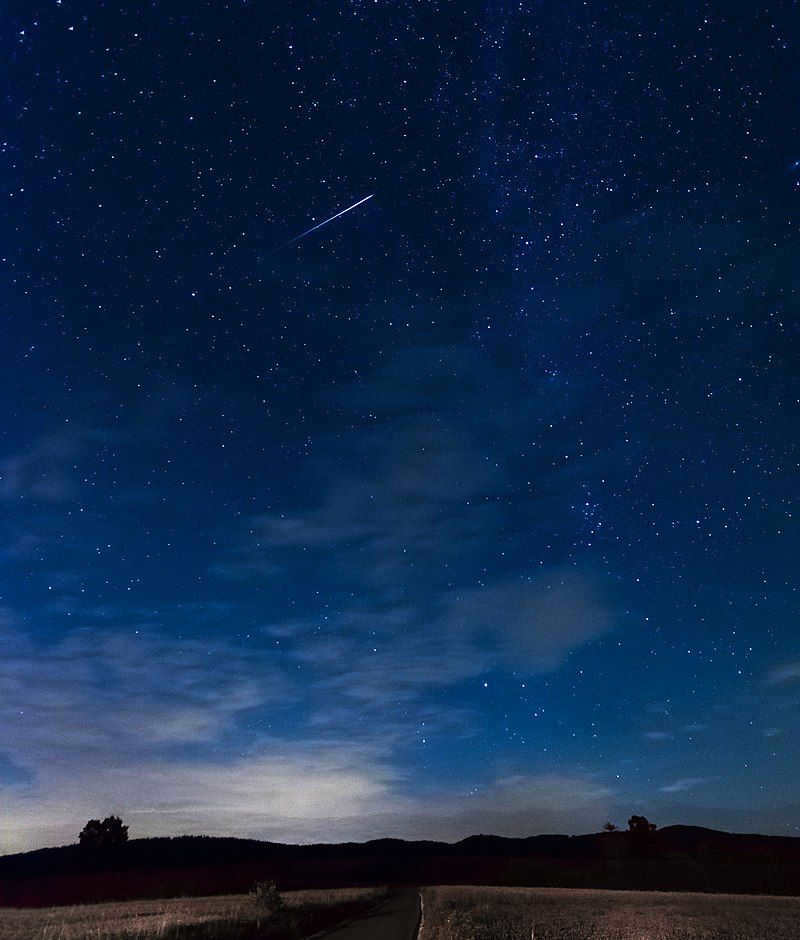
Applications for Monitoring Celestial Objects
Therefore, numerous tracking apps and websites are available for monitoring the movements of celestial bodies. Listed below are some of the most widely used ones. Although the information provided on these platforms may not be completely accurate, it can still be trusted for observational planning purposes.
Heavens-Above
Heavens-Above is a renowned website and mobile app that offers comprehensive information about the flybys of both artificial and natural satellites. It is considered to be the most popular resource of its kind globally. The platform provides detailed tracking information for a wide range of objects, including well-known ones like the International Space Station (ISS) as well as lesser-known vehicles. Users can easily generate a table displaying overflights specific to their location. This table includes the satellite’s name, brightness, time interval of overflights, azimuth, and height above the horizon in degrees. Heavens-Above also offers additional features such as information on specific instruments like the Hubble and Envisat, real-time data on the ISS altitude, and interactive satellite motion maps.
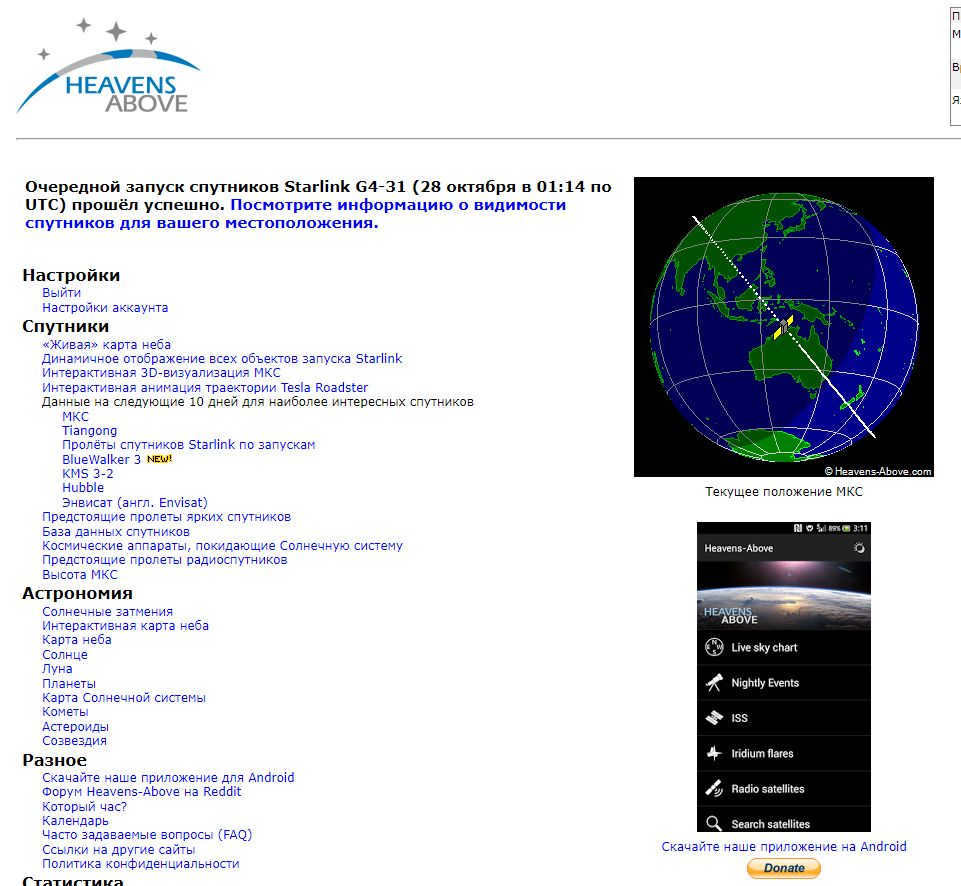
The mobile application has limited functionality compared to the web version, which can be inconvenient at times. However, considering that the project is non-commercial and free of charge, it’s understandable.
To obtain overflight data, you need to provide your location as all calculations are based on a specific point on the map. It doesn’t have to be exact, an error of +/- 10 km is acceptable. After that, select the desired section, set the date, and you will receive a table similar to the one shown below:
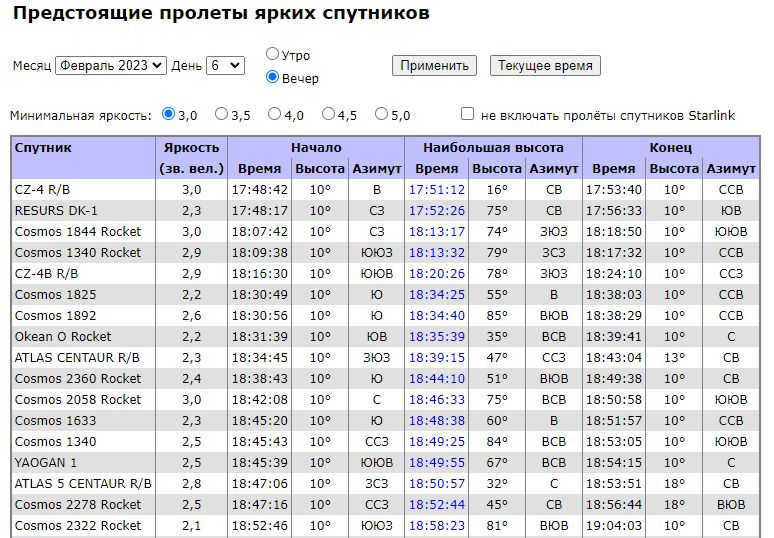
Aside from the mentioned brightness values, it is important to take note of the height above the horizon (where the horizon itself is at zero degrees and the point above the observer’s head – the zenith – is at 90 degrees) and the azimuth. In this context, azimuth refers to the direction from the observer in which the satellite flyby will occur. To get a better sense of direction, you can refer to an image like the one shown above.
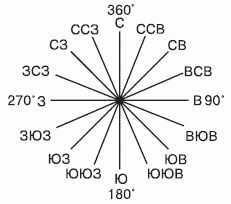
Satellite Tracker
An innovative mobile app featuring a sleek design and user-friendly tools, the Satellite Tracker provides real-time information on all artificial satellites. Additionally, users can utilize the “Sky View” function, which allows them to point their phone cameras at any area of interest and access detailed information about the objects in their vicinity. By tapping on the satellite icon located in the upper right corner of the screen, users can explore data on all available tracking objects, including background information and overflight times.
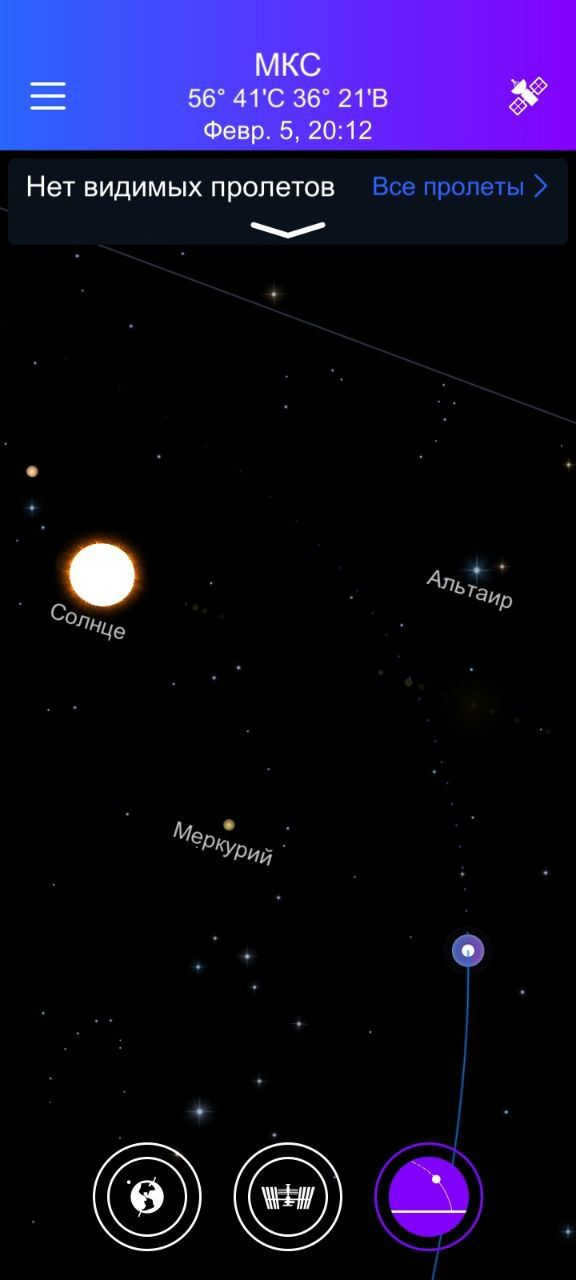
The issue lies in the fact that the free version only provides ISS tracking data, whereas the paid version, which includes information on all other satellites, cannot be obtained using a Russian Google Play or Apple Store account.
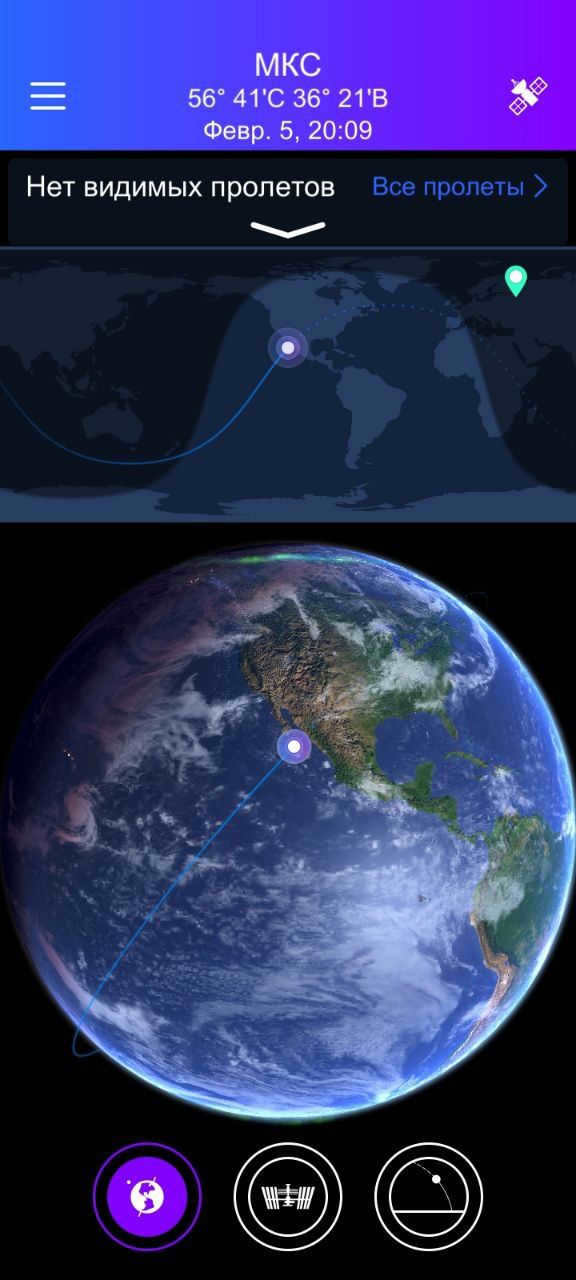
Star Walk 2
Star Walk 2 is a mobile application developed by the creators of Satellite Tracker. It is an advanced version that not only allows you to track satellites, but also provides information about planets, stars, and constellations. Additionally, it offers features such as moon phase tracking, sunrise, and sunset times. Like Satellite Tracker, Star Walk 2 also includes an augmented reality mode, which enables users to observe the sky by simply pointing their phone upwards. In some cases, if the celestial objects appear to be misaligned on the screen, the application provides an option to calibrate through its settings.
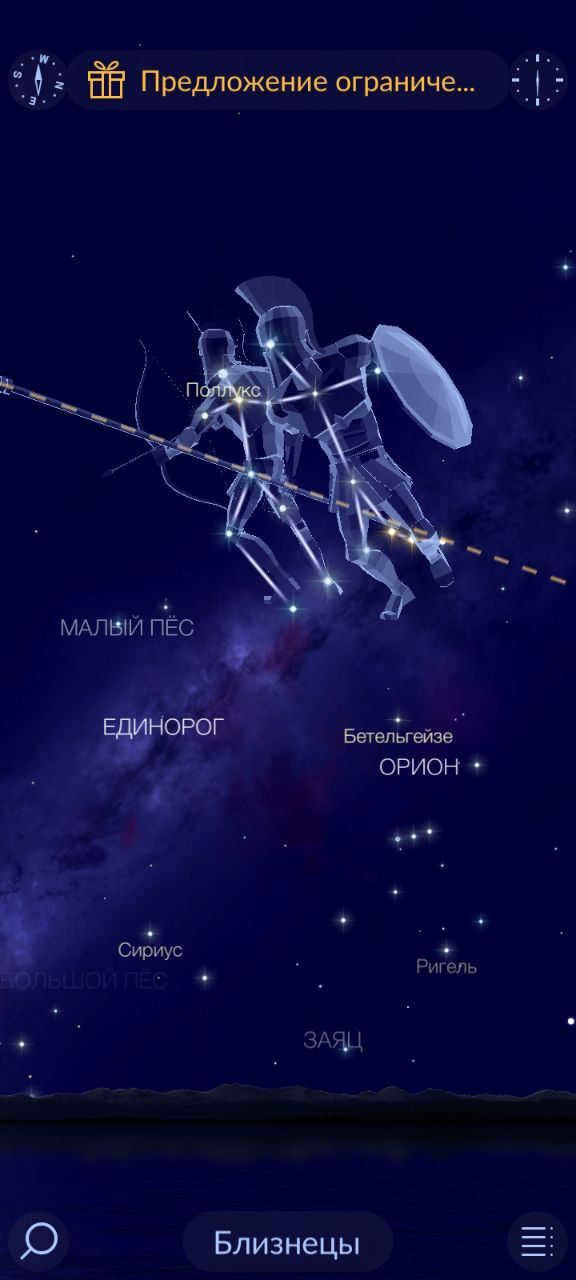
The application showcases impressive animations and an immersive soundtrack. Regrettably, users from Russia do not have access to the complete array of features.
Discover Starlink
A user-friendly monitoring tool developed by a passionate team. As its name implies, it exclusively presents data on Starlink satellites without including any other celestial bodies.
Convenient and straightforward monitoring tool created by a dedicated group of individuals. True to its name, it solely showcases information on Starlink satellites, omitting any other celestial objects.

In order to utilize it, you must input your current position via text or coordinates, and subsequently the platform will present you with the opportune time to anticipate the appearance of the coveted luminous formation. If you access the application via a mobile device, you have the option to establish a reminder for the upcoming sightings by utilizing the “Remind me” feature. In this scenario, a notification will be sent to you 30 minutes prior to the scheduled flight.
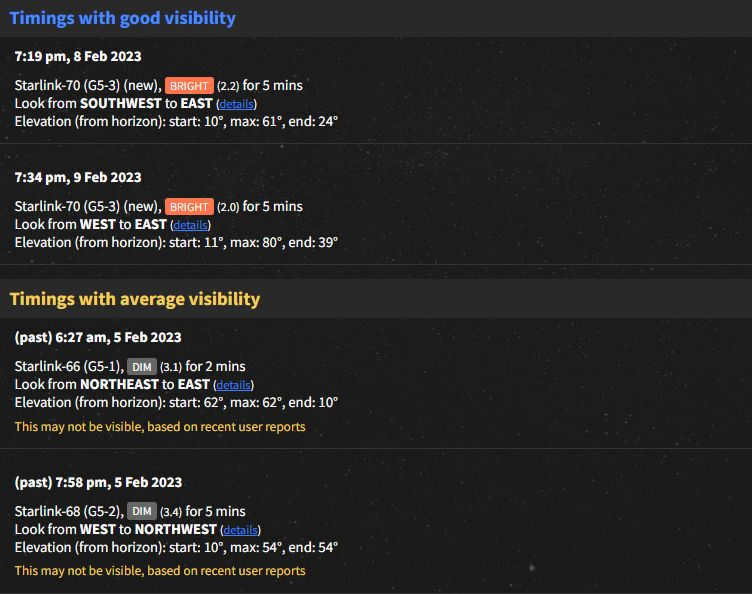
The service is available for free on both the web version and the mobile app. Typically, information regarding the movements of satellite “constellations” becomes available a few days after a new set of satellites is launched into orbit.
Satellitemap
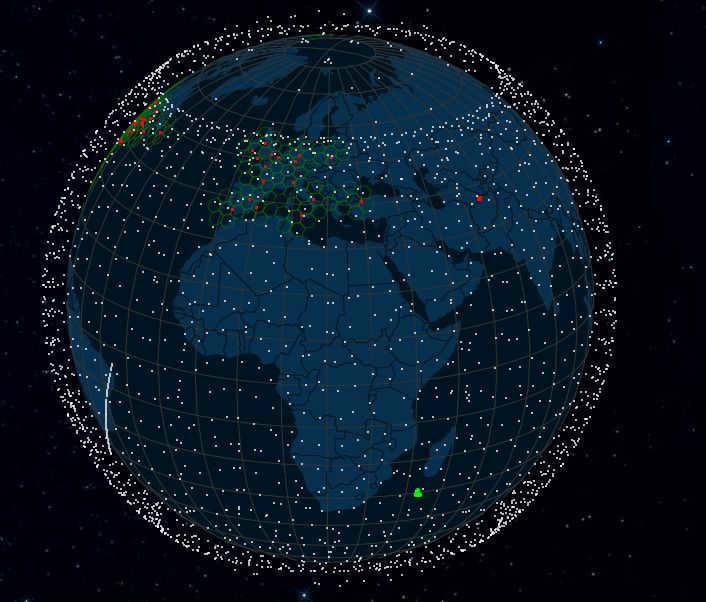
This website, similar to Google Earth, showcases the exact position of every Starlink satellite currently in orbit around Earth. It offers both general information about the entire constellation and in-depth details about each individual satellite, including its path, launch date, altitude, and more.
By adjusting the location in the “Home” section of the settings, you can use the “calculate” button to determine if a specific satellite will traverse your area.
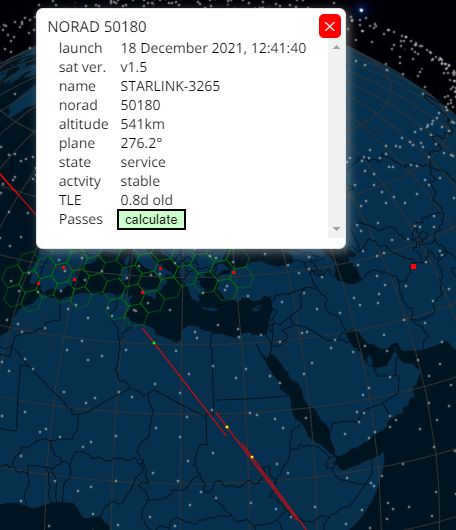
The website also provides information about the whereabouts of GPS and OneWeb satellites. Access to the site is completely free of charge.
James.darpinian.
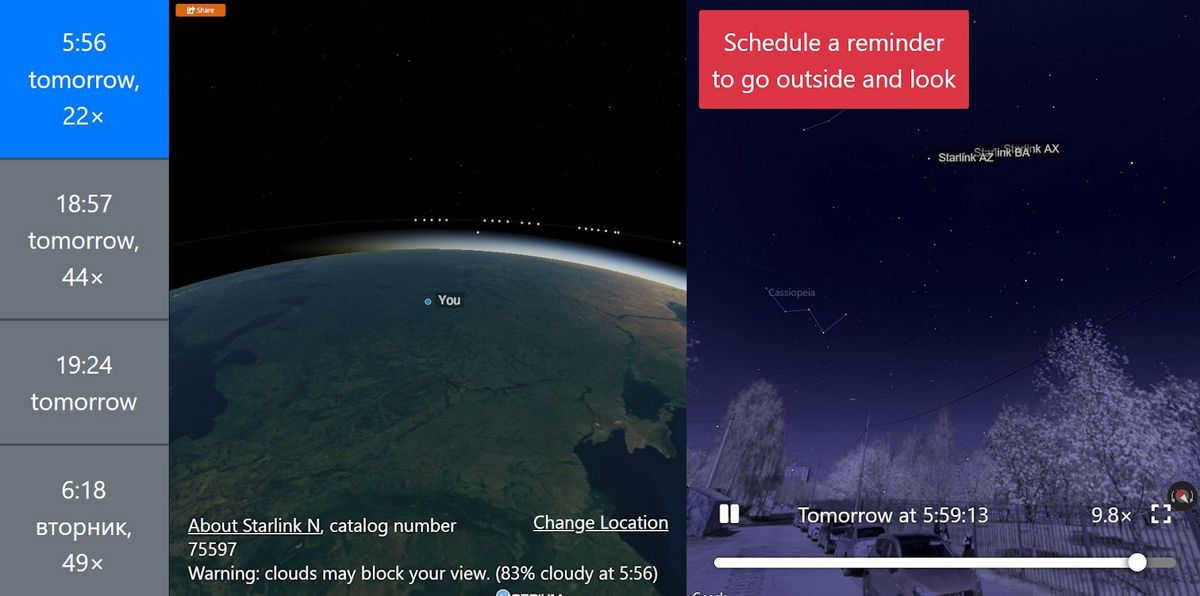
Developed by James Darpinian, a Google engineer, this website not only showcases the movement of satellites over a specific location but also provides a visual representation of their journey from Earth using Google Street View. It gives users the feeling of actually being outside and gazing up at the sky. While not all satellites are shown, it’s not limited to just Starlink. Additionally, users can set reminders for upcoming satellite flybys, such as through a calendar.

Conclusion
By utilizing these services, you can be well-prepared to observe the multitude of events that take place in the night sky. This month, for instance, there will be the launch of two additional groups of Starlinks, as well as regular flybys of the International Space Station.
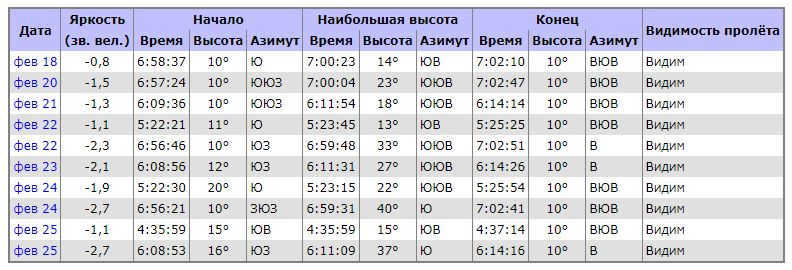
There will be a close encounter between the Moon and Jupiter on February 23, but unfortunately, it will not be visible from Russia. However, on February 28, there will be a conjunction of Mars and the Moon that can be seen from Russia. You can stay updated on the astronomical forecasts by following the information provided by the Moscow Planetarium (link). Make sure to also check the relevant apps for more information and secure your spot in the sky.
An unidentified flying object (UFO) made an appearance and left a special promo code for our blog readers:
– Get a 15% discount on all VDS plans (excluding the Warm-up plan) with the promo code HABRFIRSTVDS.
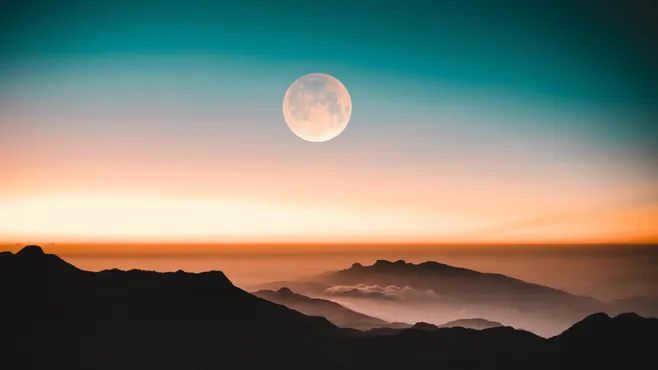
In August, the final month of summer, there will be a wealth of extraordinary astronomical events. Two supermoons will occur during this month. The first one, known as the “sturgeon” moon, will be visible to residents of Russia on the night of Wednesday, August 2. Towards the end of the month, a blue moon will also grace the sky. Find out what to expect from Earth’s natural satellite and the exact timing of its closest approach to our planet in the article “360”.
A supermoon is a phenomenon that occurs when the Moon is at its closest distance to the Earth. On the night of August 1st to 2nd, our planet’s natural satellite approached within 23,000 kilometers. During this time, the Moon will appear larger and brighter than usual.
Nikolai Zheleznov, a senior researcher and spokesperson for the Institute of Applied Astronomy of the Russian Academy of Sciences, explained that the term “supermoon” originated from astrology but has also become popular in the field of astronomy. This is because the Moon follows an elliptical orbit around the Earth, and at certain points, it comes close to our planet.
“The Earth is located at one of the foci of this ellipse, so periodically the Moon reaches the closest point of its orbit, which is known as perigee,” he clarified.
Perigee refers to the moment when the Moon is in its closest proximity to the Earth, at a distance of approximately 360 thousand kilometers. The opposite of perigee is apogee, which occurs when the Moon is at its farthest distance from our planet, about 400 thousand kilometers away. Zheleznov observed that if one carefully observes, they can notice that the Moon appears slightly smaller during apogee compared to perigee.
A super moon is when the full moon coincides with the perigee. This means that not only is the Moon at its closest point to the Earth, but it also shines with its full brilliance. This phenomenon is known as a super moon. For instance, on August 1st, the time between the two events (full moon and perigee) will be approximately 15 hours, and on August 31st, it will be around 12 hours. Therefore, the 31st of August will be the largest “super moon” of the year.
How the super moon impacts individuals and global occurrences
While the super moon is unlikely to have a direct impact on global events, there is a belief that this phenomenon can affect the well-being of individuals. Some individuals may experience changes in blood pressure due to the super moon.
According to the Radio 1 website, the super moon can also have an impact on a person’s mood, behavior, and sleep patterns. Individuals with mental disorders and neurological diseases may be particularly vulnerable during this time, as their symptoms can be exacerbated.
Exploring the Super Moon of August 1, 2023 – the significance behind its “sturgeon” name
The celestial event that we can observe in the sky on the night of August 2 is known as the “sturgeon” moon. It is during the last month of summer, a time that is considered favorable for fishing, particularly for sturgeon. It is believed that during this super moon, individuals can harness the energy from the Earth’s natural satellite and attract significant financial gains.
However, this phenomenon is also referred to by other names. The August super moon is alternatively referred to as the harvest moon, fruit moon, corn moon, cherry moon, or rice moon. These names are all associated with the harvesting season. Nevertheless, the most commonly used name is still the “sturgeon” moon.
This year, there will be two super moons in the final month of summer. The second one will occur on the night of August 31 and will be known as the blue moon. This is an exceptionally rare occurrence as we will witness this phenomenon twice in such a short span of time. Nikolay Zheleznov reminds us that our calendar month is slightly longer than the lunar month, which accounts for this unique event.
The Blue Moon is set to make its appearance on August 30th at approximately 18:52 Moscow time. During the full moon phase, it will be visible around 04:37.
“You can spot the Moon when the Sun goes down. And of course, you can observe it all night long,” Zheleznov explained.
However, one prerequisite is necessary – the weather must be good and the skies must be clear.
Guidelines for Dealing with the Super Moon
Given the potential impact of the super moon on human well-being, it is advisable to avoid engaging in conflicts with others.
It is also wise to steer clear of any provocations from others and refrain from borrowing money. Furthermore, starting a new business venture or changing jobs is not recommended during this time. Additionally, it is best to avoid consuming hot beverages and heavy meals.
However, completing important tasks is considered auspicious. The super moon appreciates orderliness. Therefore, this period presents an opportunity to declutter and make amends with friends.
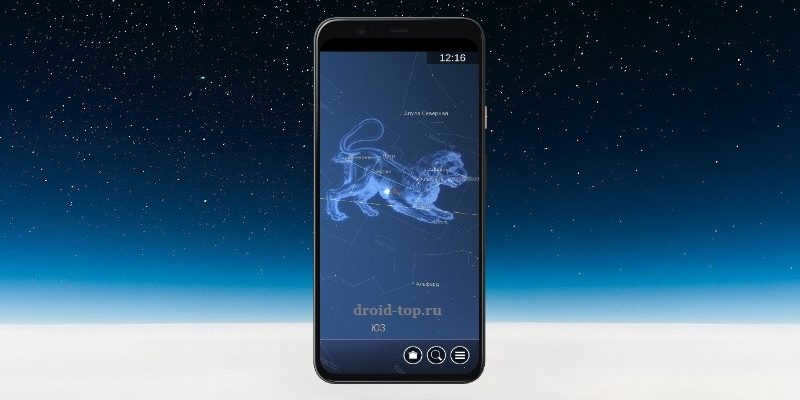
Picks
To explore the sky and identify constellations, planets, and satellites, there are various astronomy applications available with interactive star maps. These mobile apps provide real-time information about the positions of celestial objects and can be easily downloaded onto your Android device.
Here is a compilation of the top-rated space-watching apps that allow you to discover and learn about stars. They offer extensive databases filled with information about celestial bodies and also provide recommendations on the best times for observation.
Stellarium Mobile – sky map
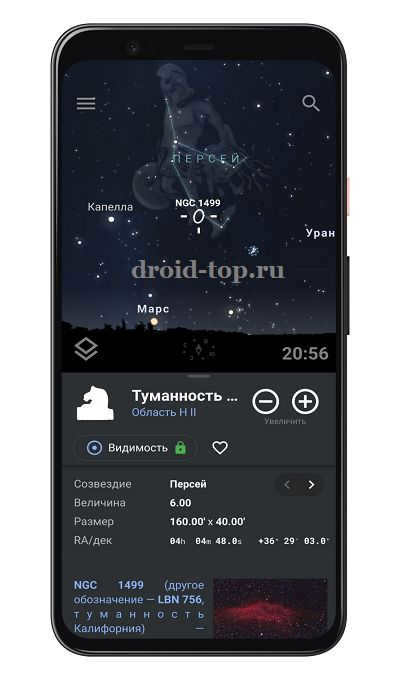
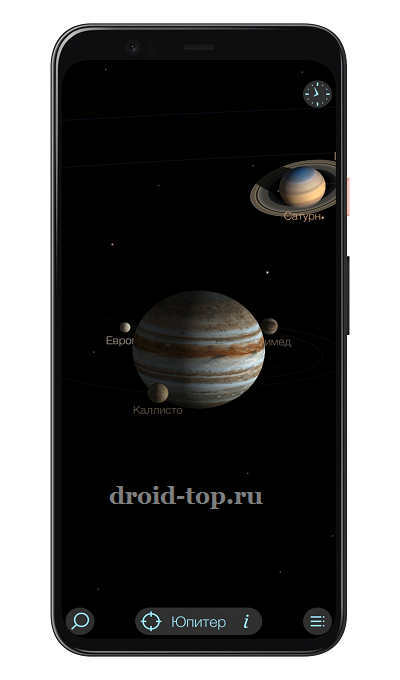 Stellarium Mobile app that provides a comprehensive map of the sky.
Stellarium Mobile app that provides a comprehensive map of the sky.
Planetarium application that allows you to use your phone’s camera to view the night sky and obtain information. It displays planets, stars, constellations, artificial satellites, and more. The app includes high-resolution images of the entire sky that can be zoomed in for a closer look.
Assists in planning observations of planets and stars for optimal viewing times.
- Modeling mode that accurately depicts the positions of celestial bodies for any given date and time.
- Provides information on satellite locations, including the ISS.
- There is a free version of the app available with a Russian interface.
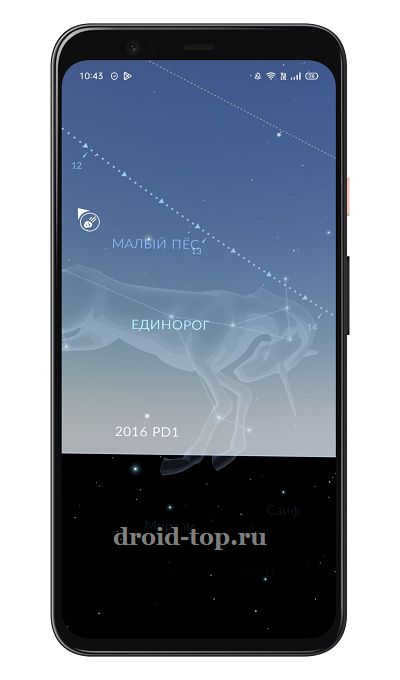
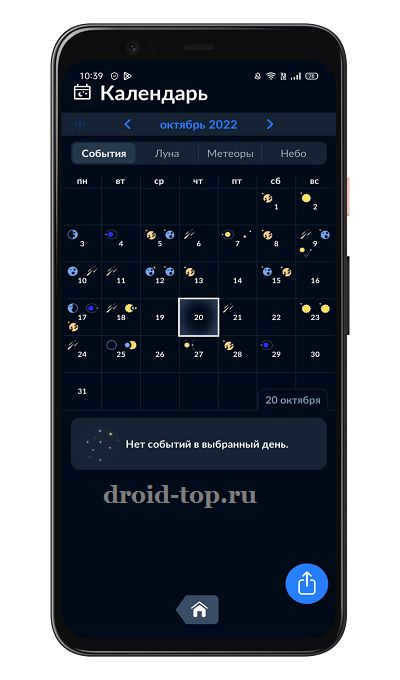
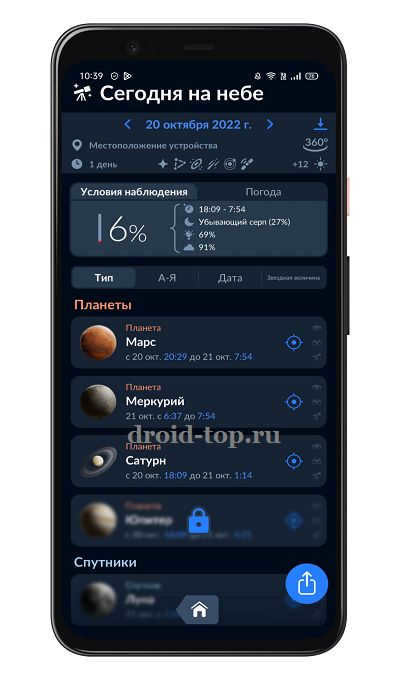 Sky Tonight – a tool that provides real-time information about constellations.
Sky Tonight – a tool that provides real-time information about constellations.
If you are interested in knowing what celestial events can be observed today and how to locate specific constellations or objects in the sky, this application is perfect for you. Simply point your phone towards the sky and you will receive detailed information about celestial bodies and their motion trajectory.
The augmented reality feature allows you to view a map of the starry sky that corresponds to your smartphone’s location. Additionally, the astronomical calendar provides information about upcoming events such as eclipses, meteor showers, and oppositions, helping you plan your observations.
- Night mode is available for convenient observation in the dark.
- High-resolution photos of space objects are also included.
- The Star Walk 2 app allows you to track the positions of constellations and planets during any desired time period.
- Get reminders for solar eclipses, full moons, and other important astronomical events.
Star Walk 2
An app that tracks the positions of stars, planets, satellites, and constellations on a space map. Simply point your phone at the sky to see the real-time location of celestial bodies (requires a device with a built-in compass sensor).
Search by name is available, allowing you to find the location and information about any desired object. The free version may include advertising.
- View the star atlas during both daytime and nighttime.
- Access information about moon phases, the exact positions of stars, sunrise/sunset times, and more.
- Object tracking: stars, planets, asteroids, comets, meteor streams, constellations, satellites, etc.
SkySafari
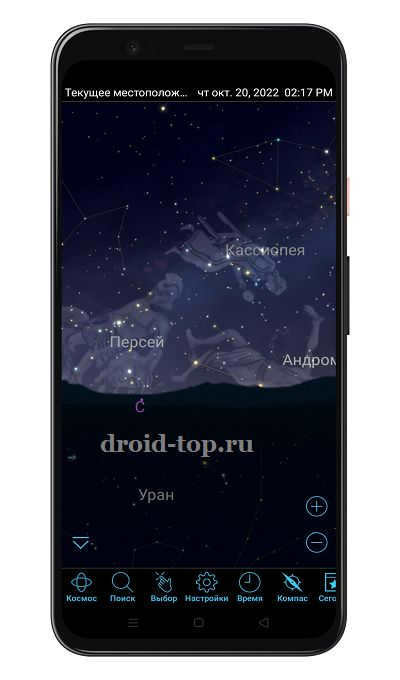
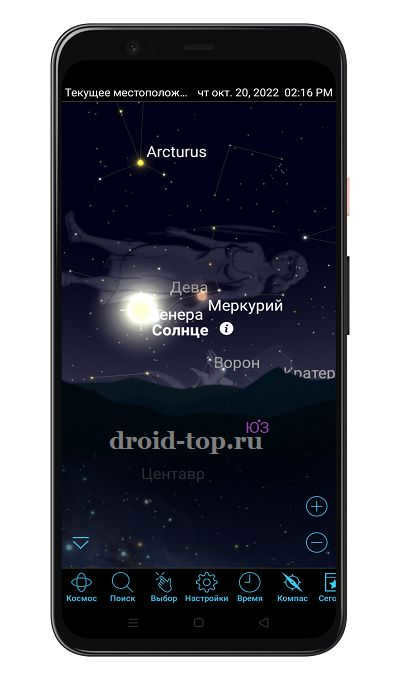 SkySafari star map on Android devices.
SkySafari star map on Android devices.
Planetarium app with a vibrant design and the ability to locate celestial bodies. Constellations are accompanied by illustrations and names in Russian. You can track various objects, including asteroids and man-made satellites like Starlink and ISS.
It provides prompts for the best observation times for objects. By moving your phone, you can explore the universe not only above the horizon but also from the opposite side of the Earth.
- Quick search feature with sorting options for stars, planets, comets, galaxies, satellites, etc.
- The placement of stars in the past or the future can be displayed.
- Compass and manual map scrolling mode are available.
Star Map
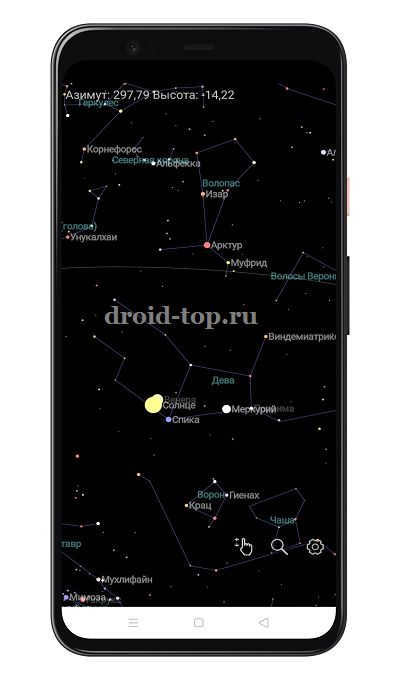
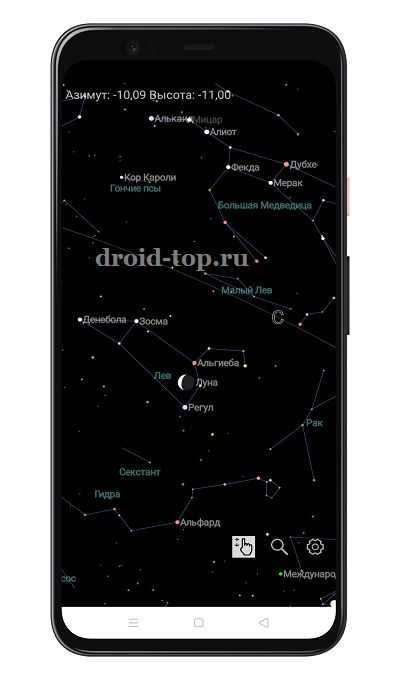 The astronomical application “Star Map”.
The astronomical application “Star Map”.
The program allows you to view cosmic bodies in dual mode, either by manually moving the map or by using the phone sensors for auto-detection. The interface and names are translated into Russian, and you can also search by name.
- The app shows the location of planets, constellations, and stars.
- It can also identify the ISS and Chinese space station.
- Recommended observation times are provided.
- The map can be zoomed in and out.
Stellar Map
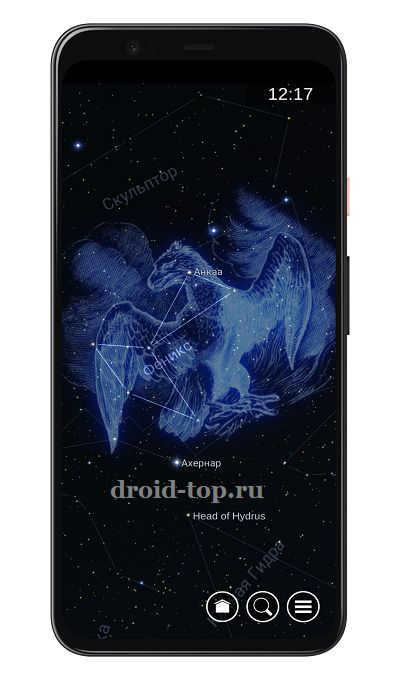
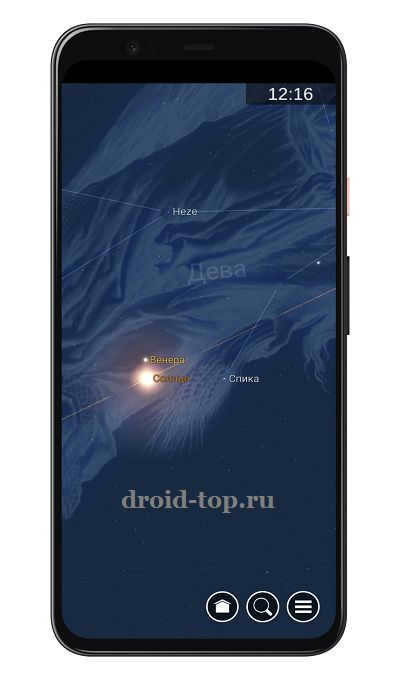 Stellar Map is a software designed to identify constellations and planets.
Stellar Map is a software designed to identify constellations and planets.
Stellar Map features a comprehensive guide to the celestial sky, which can be explored by swiping your finger across the screen. It includes a vast database of over 120,000 stars, meteorites, satellites, planets, the solar system, comets, and other celestial objects.
Perfect for stargazing on your mobile device. You can download the Android application for free. The user interface is available in Russian. The constellations are depicted with unique illustrations.
SkEye
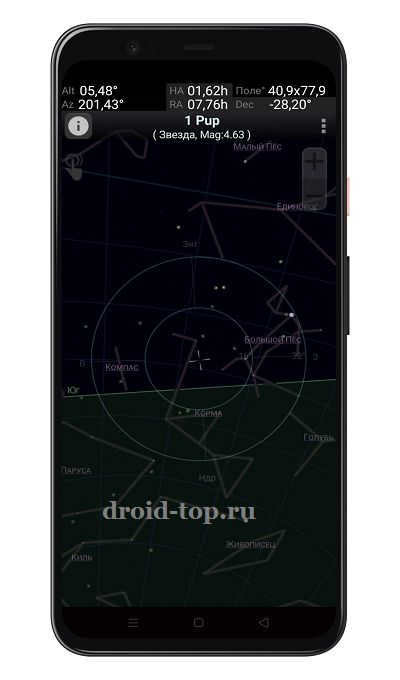
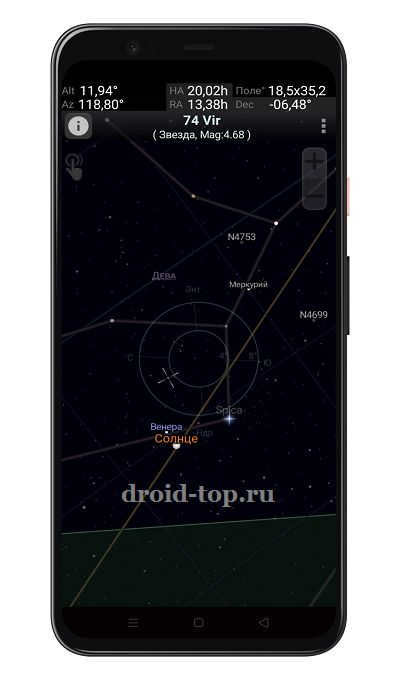 Experience the wonders of the universe with the SkEye app.
Experience the wonders of the universe with the SkEye app.
Discover a user-friendly star map that allows you to observe and track constellations, stars, planets, and more. Stay informed with details on sunrise time, sunset time, lunar phases, and the best times for observation.
- Navigate the sky with two movement modes: compass and manual.
- Enjoy the app in Russian.
- Download the application for free.

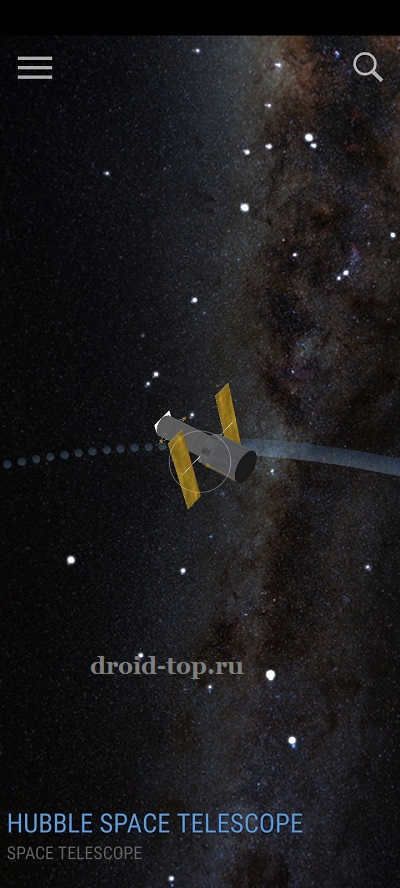 Discover celestial objects using the SkyView app.
Discover celestial objects using the SkyView app.
An innovative planetarium application that can superimpose a detailed star map onto your camera’s viewfinder. Experience real-time stargazing, observe stars, and access relevant information about them.
The app’s user interface is primarily in English. However, for those who are not fluent in English, they can rely on visual representations of constellations.
- Identifies stars, planets, comets, satellites, and more.
- Compass mode allows for seamless alignment of the star map with the camera’s perspective.
- Customizable settings to toggle the display of various objects and information.
- Certain features can be accessed offline, without an internet connection.
Sky Map
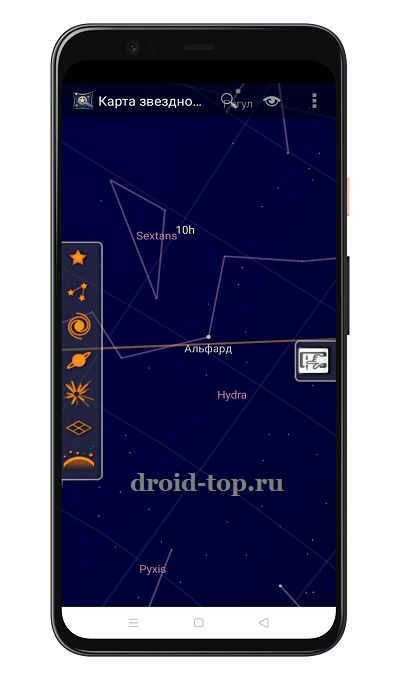
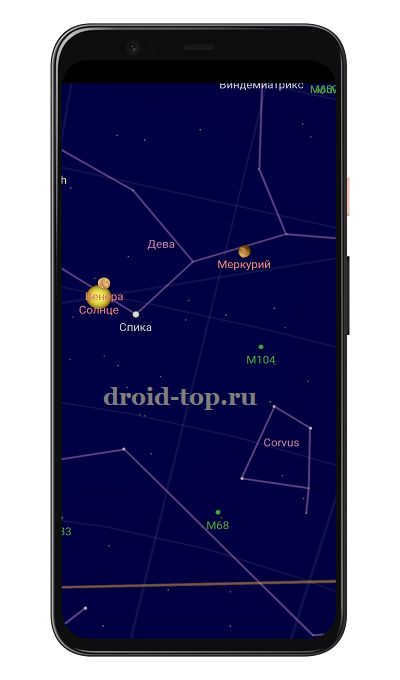 Sky Map Planetarium.
Sky Map Planetarium.
A user-friendly starry sky map for locating celestial objects. It includes a feature that determines your device’s location and syncs the image with the position of the stars and planets.
One drawback of the app is its simple interface and incomplete translation of names into Russian. However, the application is free and ad-free.
- Option to disable the display of space objects such as stars, planets, comets, satellites, etc.
- Time Travel mode automatically moves stellar objects to the desired time and date.
- Search for specific objects in the sky.
- The phone must have a built-in compass for automatic orientation mode.
- No internet connection is needed (except for certain features).
Solar Walk – Space Atlas
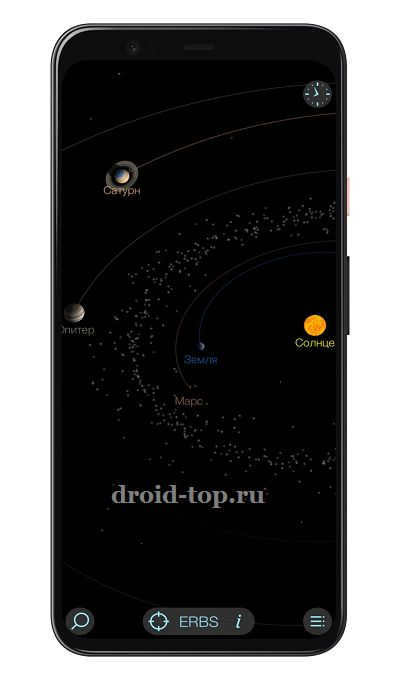 The Solar Walk app allows you to explore the solar system.
The Solar Walk app allows you to explore the solar system.
This planetarium lets you track the planets in our solar system. It displays the planets’ positions relative to the Sun for any given date and time, down to the second. Additionally, it provides information, photos, and trajectories of various artificial satellites orbiting the Earth (such as the ISS).
- This free app has a Russian interface.
- It offers a 3D atlas of the solar system that allows you to navigate the map and observe it from different perspectives.
- You can also view the position of the solar system within the galaxy.
- Explore planets, their satellites, asteroids, comets, and stars.
Daff Moon – Phases of the Moon
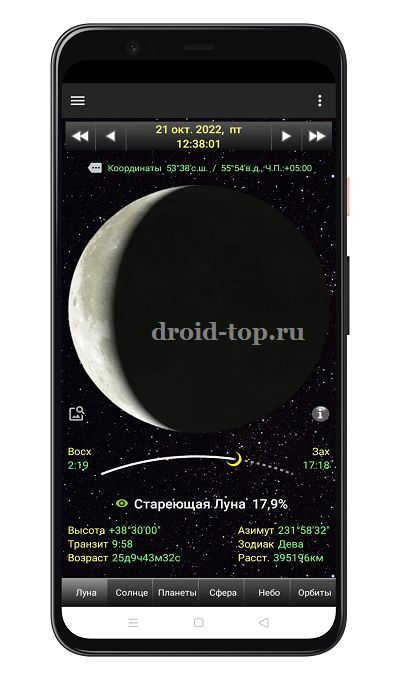
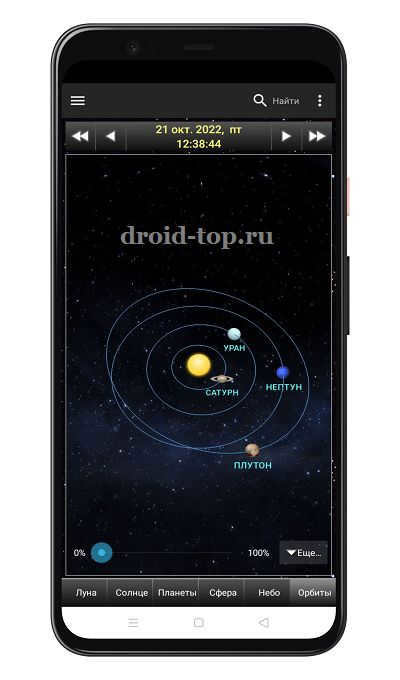
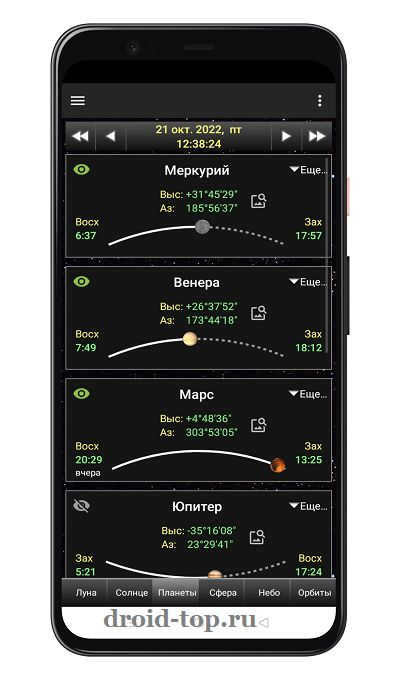 Observe the moon and planets in Daff Moon.
Observe the moon and planets in Daff Moon.
By utilizing the Daff Moon program, you can gain valuable insights into the various phases of the moon, as well as the rising and setting times, planetary positions, and solar and lunar eclipses. Additionally, this program will provide you with timely reminders of upcoming astronomical events.
- Experience a detailed view of the Moon’s surface with the ability to zoom in and out.
- Access information on super moons, perigee/apogee, eclipses, equinoxes, solstices, and more.
- Utilize the astronomical calculator to determine the specific date and time when the Sun, Moon, or a particular planet will be in your desired position.





